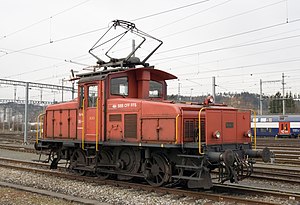SBB Ee 3/3
| Ee 3/3 | |
|---|---|
|
Ee 3/3 of the third series in Oberwinterthur
|
|
| Numbering: | 16311-16460 |
| Number: | 136 |
| Year of construction (s): | 1928-1966 |
| Axis formula : | C. |
| Length over buffers: | 9060-9510 mm |
| Service mass: | 39–45 t |
| Top speed: | 40-50 km / h |
| Hourly output : | 428-508 kW |
| Starting tractive effort: | 88-118 kN |
| Hourly traction: | 56-69 kN |
| Drive: | Coupling rods |
The Ee 3/3 are electric shunting locomotives of the Swiss Federal Railways . Three copies were built for other customers.
The advancing electrification of the SBB network increasingly required a replacement for the E 3/3 steam locomotives used in shunting services . For this purpose, two Ee 3/4 prototypes were commissioned around 1922 , which still had a running axle in order to be able to comply with the limitation of the axle load to 15 t. From 1928 the series version was produced without a running axle (hence Ee 3/3), initially with the driver's cab at one end (which led to the nickname "Iron"). The locomotive was so successful that the last Ee 3/3 was not built until 1966 , whereby large parts of the construction remained the same over time.
In addition, the two-system locomotives SBB Ee 3/3 II (15kV, 16 2/3 Hz (Switzerland); 25kV, 50 Hz (France)) and the four-system locomotives SBB Ee 3/3 IV (15kV, 16th century ) were later developed for use on third-party power systems 2/3 Hz; 25kV, 50 Hz; 1500 and 3000V direct current (Italy, main network France)).
Construction and versions
In order to be clear in both directions in shunting operations, the driver's cab was arranged between the apparatus superstructures. A single drive motor drives a drive axle, which in turn ensures the power transmission to the wheels via a coupling linkage. This antique-looking design was retained until the last Ee 3/3 in 1966, although single-axle drive had long been common at that time.
| Numbers | Years of construction | SLM factory numbers | traction | Remarks |
|---|---|---|---|---|
| 16311-16326 | 1928 | 3188-3193, 3224-3233 | 88 kN | Driver's cab at one end of the locomotive ("iron", "shoe"). 8 machines in use until 1997 |
| 16331-16350 | 1930-1931 | 3395-3404, 3470-3479 | 88 kN | New control for faster switching of the speed steps |
| 16351-16376 | 1932-1942 | 3517-21, 3615-17 / 32-33 / 86-88, 3705-07 / 54-57 / 72-77 |
88 kN | |
| 16381-16414 | 1944-1947 | 3798-3805, 3836-3841, 3871-3876, 3885, 3898-3904, 3970-3945 |
98 kN | New top speed 50 km / h, weight reduced from 45 to 39 t SLM No. 3806 with SAAS electrics supplied as BLS 401 |
| 16421-16430 | 1951-1956 | 4034-4037, 4151-4156 | 118 kN | Weight increased again to 45 t due to ballast, new gearbox with 45 km / h |
| 16431-16440 and PTT 4 |
1961–1962 | 4350-4360 | 118 kN | |
| 16441-16460 and EBT 131 |
1966 1967 |
4590-4610 | 118 kN | Last version again with step switch instead of hopper battery |
business
The Ee 3/3 was procured as a shunting locomotive for light and medium-duty service. Initially they were also used for light freight trains, nowadays they are much too slow with a top speed of 50 km / h. The Ee 3/3 do not have multiple controls.
The somewhat newer Ee 3/3 can still be found today in larger train stations, but are increasingly facing competition from modern diesel locomotives. The locomotives assigned to the Passenger Transport division will be gradually replaced by the SBB Ee 922 from 2010 .
See also
swell
- Peter Willen: Locomotives in Switzerland, standard gauge traction units. 3rd edition, Orell Füssli Verlag, Zurich 1975, ISBN 3-280-00800-X , pages 37–41, 133 and 172
- Kaspar Vogel: The Swiss Locomotive and Machine Factory 1871–1997. Minirex, Luzern 2003, ISBN 3-907014-17-0

